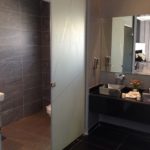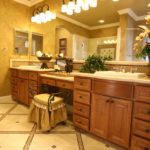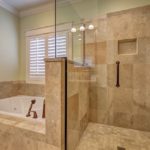Bathroom Remodeling Tips to Increase The Value of your Home
Some do-it-yourself experts recommend a fresh coat of paint, new tile, a shiny new sink and great cabinets to transform an ordinary bathroom into an extraordinary spa – but that’s just what the eye can see. Yes, your refinished bathroom will look different but will it hold its value? Not unless you think first of what’s behind the paint and tile and consider how to protect it from the greatest threat in a bathroom: moisture, mold and mildew.
Upgrading your walls, ceilings and subfloors before you paint, install tile or hang a fancy new mirror can ensure your new bathroom will stand up to everyday splashes, showers and relaxing tub soaks, as well as dreaded mold and mildew that can come from these steamy, wet environments.
Anitra Mecadon, host of DIY Network’s “Mega Dens” and spokesperson for National Gypsum, is on a mission to prevent major mold and mildew problems by recommending homeowners start at the studs. Here’s her advice when it comes to the No. 1 room people remodel in their homes – bathrooms:
Look for ideas
Popular upgrades include decorative tile or stone in the tub and shower areas. You can also consider multiple showerheads or steam enclosures to give your bathroom “spa appeal” without the worry. Visit us on the popular home improvement site Houzz for bathroom inspiration!
Budget and plan
* The average cost of a bathroom remodel is around $16,000, so create a budget so you know how much you can comfortably spend.
* If you plan to have someone do it for you, get an estimate from a contractor before you start.
* Shop on your own, with a contractor or interior designer to select building materials, fixtures and appliances.
* Remember that bathrooms require two kinds of materials to help protect walls and floors: mold- and moisture-resistant drywall for areas behind mirrors, sinks or vanities, and cement board for the critically wet areas, such as tubs and showers.
Be careful
* Prepare for a demolition phase to tear out the tub, sink, tile, walls and flooring.
* Be careful of pipes, air ducts and electrical wires behind the walls, ceilings and under the floors.
* Measure twice, cut once.
* You can never be too safe – use appropriate safety gear.
Add value with walls and floors
* After adding insulation, install mold- and moisture-resistant drywall in your bathroom.
* For a strong base that stands behind every great finish – like tile, slate or marble – use a PermaBase Cement Board in critically wet areas around tubs and showers.
Other notes to consider
* Ask a friend to help for easier installation.
* Forget traditional green board because it’s no longer approved by most building codes.
* Seal areas around the tub and sink with mildew-resistant caulk and grout to discourage discoloration.
* Paint walls with mildew-resistant primer and paint, which can cut down on future maintenance.
* Add an exhaust fan for additional moisture control.
For more information on bathroom remodeling, visit our bathroom renovation page!








